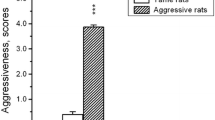Abstract
Male mice differing in their genetically determined disposition for isolation-induced intermale aggression were compared on behaviors related to predatory aggression. An ongoing sequence of selective breeding established high-aggressive (Turku Aggressive: TA) and low-aggressive (Turku Non-Aggressive: TNA) lines from an outbred Swiss albino foundation stock. The parental strain, designated the Normal (N) strain, has been kept as a control line and is bred without regard to aggressiveness. Testing consisted of dropping a live cricket into the home cage of the individually housed experimental mice. Results showed that the TA males displayed shorter latencies to attack and spent more time in chasing, attacking, and consuming crickets than did TNA and N males. The TNA males displayed significantly less predatory aggression than both the TA and N males. When brothers of the males tested for predatory aggression were tested for intermale aggression, a similarly significant effect of breeding line was obtained for the latency to attack. Testing consisted of placing an intact male mouse into the cage of the male to be tested. The results suggest that there may be parallels in genetic variation between intermale and predatory attacking.
Similar content being viewed by others
References
Barr, G., Gibbson, J. L., and Moyer, K. E. (1975). The relationship between mouse killing and interspecific fighting in albino rats.Behav. Biol. 14:201–208.
Benus, R. F., Bohus, B., Koolhaas, J. M., and van Oortmerssen, G. A. (1991). Heritable variation for aggression as a reflection of individual coping strategies.Experientia 47: 1008–1019.
Brain, P. F. (1975). What does individual housing mean to a mouse?Life Sci. 16:187–200.
Brain, P. F., and Al-Maliki, S. (1978). A comparison of intermale fighting in standard oppenent tests and attack directed towards locusts by TO strain mice: Effects of simple experimental manipulations.Anim. Behav. 26: 723–737.
Butler, K. (1973). Predatory behaviour in laboratory mice: Strain and sex comparisons.J. Comp. Physiol. Psychol. 85:243–249.
Cairns, R. B., MacCombie, D. J., and Hood, K. E. (1983). A developmental-genetic analysis of aggressive behavior in mice. I. Behavioral outcomes.J. Comp. Psychol. 97:69–89.
Ebert, P. D. (1983). Selection for aggression in natural population. In Simmel, E. C., and Hahn, M. (eds),Aggressive Behavior: Genetic and Neural Approach, Lawrence Erlbaum, Hillsdale, NJ, pp. 103–125.
Elwood, R. W. (1991). Ethical implications of studies on infanticide and maternal aggression in rodents.Anim. Behav. 23:841–849.
Haber, S. J., and Simmel, E. C. (1976). Tail rattling and agonistic behavior in mice: Coincidal or causal?Bull. Psychon. Soc. 7:84–86.
Johnson, R. N., De Sisto, M. J., and Koening, A. B. (1972). Social and developmental experience and interspecific aggression in rats.J. Comp. Physiol. Psychol. 79:237–242.
Kvist, B. (1989). Learning in mice selectively bred for high and low aggressiveness.Psychol. Rep. 64:127–130.
Lagerspetz, K. M. J. (1964). Studies on the aggressive behaviour of mice.Ann. Acad. Sci. Fennicae Ser.B 131:3.
Lagerspetz, K. M. J., and Lagerspetz, K. Y. (1971). Changes in the aggressiveness of mice resulting from selective breeding, learning and social isolation.Scand. J. Psychol. 12:241–248.
Lagerspetz, K. M. J., and Mettälä-Portin, R. (1968). Simulation of cues eliciting aggressive responses in mice at two age levels.J. Genet. Psychol. 113:53.
Lagerspetz, K. M. J., and Sandnabba, N. K. (1982). The decline of aggressiveness in male mice during group caging as determined by punishment delivered by the cage mates.Aggress. Behav. 8:319–334.
Leshner, A. J., and Nock, B. L. (1976). The effect of experience on agonsitic responding. An expectancy theory interpretation.Behav. Biol. 17:561–566.
Lynds, P. G. (1980) Intermale fighting and predatory behavior in house mice: An analysis of behavioral content.Aggress. Behav. 6:139–147.
Moyer, K. E. (1976).The Psychobiology of Aggression, Harper & Rowe, New York.
Parmigiani, S., and Brain, P. F. (1983). Effects of residence, aggressive experience and intruder familiarity on attack shown by male mice.Behav. Proc. 8:45–57.
Sandnabba, N. K. (1986a). Changes in male odours and urinary marking patterns due to inhibition of aggression in male mice.Behav. Proc. 12:349–361.
Sandnabba, N. K. (1986b). Effects of selective breeding for high and low aggressiveness and of fighting experience on odor discrimination in mice.Aggress. Behav. 12:359–366.
Sandnabba, N. K. (1986c). Heredity, Fighting Experience and Odour cues: Factors Determining the Aggressive Interaction in Mice. Rep. Dept. Psychol.: Abo Akad., Monograph Supplement, 3.
Sandnabba, N. K. (1990). Differences between aggressive and nonaggressive mice in odour signals and marking behaviour. In Macdonald, D. W., Müller-Schwarze, D., and Natynczuk, S. E. (eds),Chemical Signals in Vertebrates., Vol. 5, Oxford University Press, Oxford, pp. 459–464.
Sandnabba, N. K. (1992). Aggressive behavior in female mice as a correlated characteristic in selection for aggressiveness in male mice. In Björkqvist, K., and Niemelä, P. (eds),Of Mice and Women, Aspects of Female Aggression, Academic Press, San Diego, pp. 367–379.
Scott, J. P. (1992). Aggression in canine females. In Björkqvist, K., and Niemelä, P. (eds)Of Mice and Women. Asspects of Female Aggression, Academic Press, San Diego, pp. 307–316.
Thomas, K. (1969). Predatory behavior in two inbred strains of mice.Psychon. Sci. 15:13–14.
van Oortmerssen, G. A., and Bakker, T. C. M. (1981). Artificial selection for short and long attack latencies in wild Mus musculus domesticus.Behav. Genet. 11:115–126.
Author information
Authors and Affiliations
Rights and permissions
About this article
Cite this article
Sandnabba, N.K. Predatory aggression in male mice selectively bred for isolation-induced intermale aggression. Behav Genet 25, 361–366 (1995). https://doi.org/10.1007/BF02197286
Received:
Accepted:
Issue Date:
DOI: https://doi.org/10.1007/BF02197286



